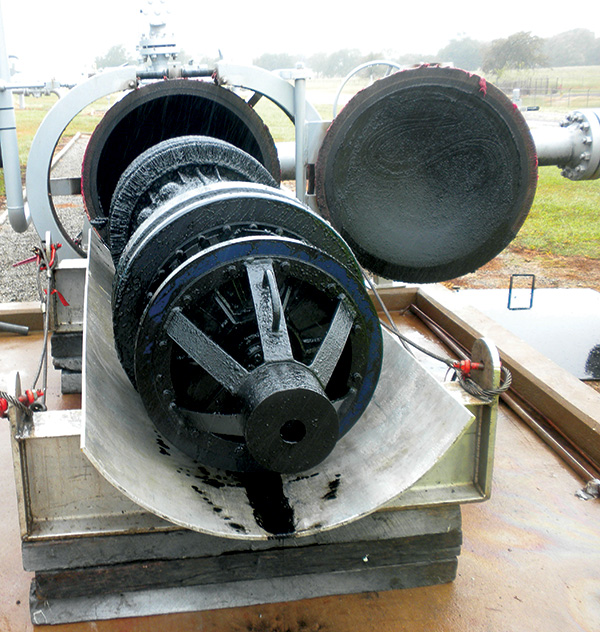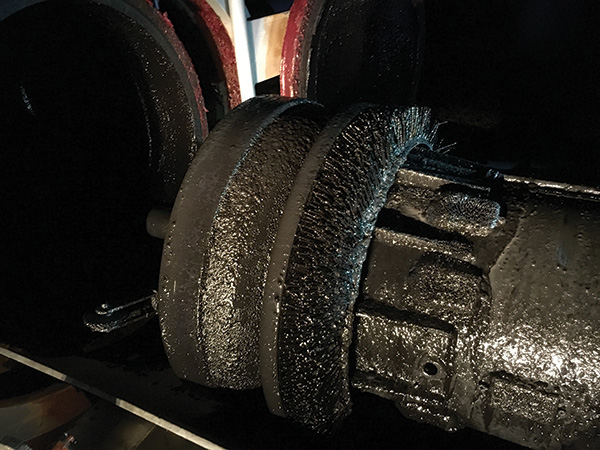August 2019, Vol. 246, No. 8
Pigging Update
Speed Control Cleaning Pigs Are Multi-Purpose
High-velocity natural gas pipelines pose a challenge to effective cleaning for corrosion mitigation purposes, maintaining throughput efficiency and pre-inline inspection (ILI) cleaning runs.
Studies show the best pipeline cleaning occurs when the tool runs at about 8 mph (3.57 m/s), allowing brushes, magnets, cups and discs to do their job. Speeds over 10 mph (4.47 m/s) tend to bypass the debris and liquids, there-by proving ineffective.
Since 2010, Inline Services has met the demand for speed control (pig) cleaning tools in pipeline sizes 30-inch through 42-inch. Pipeline cleaning speeds have been safely controlled by these tools in pipelines with gas flow volumes as high as 1.874 Bcf and up to 33.1 mph (14.7 m/s) gas flow velocity. More recently, a demand has developed for speed-controlled cleaning of pipelines with multiple 1.5 D bends.
To meet this challenge, Inline Services has designed and manufactured a series of 1.5 D short-radius bend capable Speed Control Cleaning Pigs (SCP) tools ranging from 30 inches to 36 inches with larger sizes in the planning stages.
The SCP onboard technology maintains optimal cleaning speeds of 6-10 mph (2.68 to 4.47 m/s) within a gas flow velocity of up to 33 mph (14.75 m/s). In addition, the SCP records electronics and the (inertial measurement unit) IMU collects tool performance and pipeline configuration data that can be exported and analyzed onsite.
The new SCP Tool recently exceeded expectations during a project involving over 300 miles of 30-inch and 36-inch pipelines containing numerous 1.5 D short radius bends. In addition to providing the SCP tool, a team of experts was provided to assist with the safe operation, handling and turnaround of the tools on-site.
The overall objectives of the effort were:
safe and effective pipeline cleaning with and without the use of cleaning chemicals even distribution of corrosion inhibitors maintaining gas throughput delivery commitments to downstream customers, while the pipeline cleaning was in progress.
Overview
Phase I – Proving: Tools were specifically tailored for each pipeline. Each section was first “proved” using an appropriate SCP configuration to ensure the tool could traverse safely through each pipeline section with no obstructions.
Phase II – chemical cleaning: The client-selected chemical vendor provided a unique cleaning chemical mixture for each section of the line. The Inline Field Services team reconfigured the SCP with discs, cups, brushes and magnets to disperse the chemicals evenly as per the chemical vendors’ specification.
The vendor injected the cleaning chemicals at specific locations in each section of the line to ensure the correct amount of chemical was dispersed. As the SCP traveled through the line, it disseminated the chemical onto the pipeline wall. This step was repeated, and the pig was reconfigured on-site until the desired chemical spread result was achieved and the tool was then prepared for the next phase.
Phase III – dry run: The objective of a “dry run” was to rid the pipeline of any lingering cleaning chemicals from Phase II of the project.
After obtaining the desired results in Phase II, our field services team reconfigured the SCP with discs, cups, brushes and magnets that would provide the best results for a dry run or “sweep” without the insertion of any cleaning chemicals.
Phase IV – corrosion inhibitor application: The SCP was reconfigured for even distribution of corrosion inhibitor on the pipeline wall. Similar to the chemical cleaning technique used in Phase II, the corrosion inhibitor was formulated by the clients’ vendor and created specifically for these lines.
The vendor’ application specifications, required the chemicals to be injected at strategically selected sections of each line. Once the chemicals were injected by the vendor, the SCP traveled through the lines, evenly dispersing the chemical to manufacture specification.
While the normal gas flow velocity was maintained, the SCP averaged an ideal control speed of 7 mph (3.12 m/s), allowing for both efficient cleaning and no interruption of gas delivery.
Other key features of the SCP include its on-site reconfiguration capabilities. Most high-flow pipeline pigging jobs consist of several runs in order to achieve the desired result. Each run has a specific purpose and may require a unique configuration of accessories to address the result.
Since the result is not reality until the run is complete, decisions are made at the end of each run based on what liquid and debris was and was not displaced. The ability to quickly identify and install the most effective configuration of discs, cups, brushes and magnets for subsequent runs on-site, is the key to minimizing risk and costs associated with the transport and off-site pig reconfiguration.
In addition, the recorded tool performance and IMU data was downloaded and analyzed onsite. The immediate access to the SCP’s recorded data was key in streamlining the preparation of the tool for subsequent runs, as well as effective communication of job status to client project managers.
To complement the SCP’s ability to maintain optimal cleaning speed within high flow rate environments, the SCP design also offers comprehensive safety features allowing the tool to navigate itself through obstructions safely via preset shutdown sequence settings that are customizable to meet the pipeline’s characteristics and potential design obstacles that could prevent the safe passage of the SCP.
The project was an overwhelming success. The SCP performed flawlessly in all phases. The cups and discs, also manufactured by Inline Services, performed as expected, and the tool delivered accurate, comprehensive data following each run. P&GJ








Comments